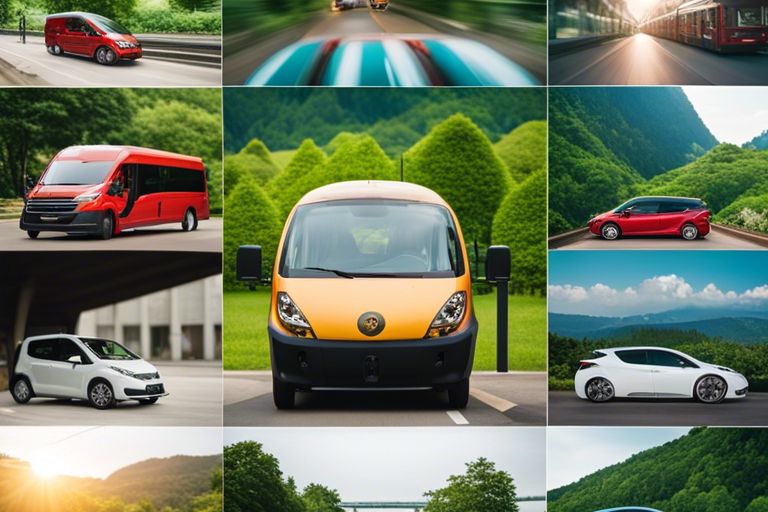In today’s society, it is imperative for individuals to seek out sustainable and eco-friendly transportation options in order to reduce their carbon footprint on the environment. With the rise of global warming and environmental degradation, it has become increasingly important for everyone to play a part in reducing their impact on the planet. The transportation sector is one of the leading contributors to greenhouse gas emissions, making it crucial for individuals to consider alternative modes of transportation that are both efficient and environmentally friendly.
When it comes to eco-friendly transportation options, there are a plethora of choices available to modern consumers. From electric vehicles to public transportation to biking and walking, there are several alternatives that can significantly reduce carbon emissions and lessen the environmental impact of transportation. In this blog post, we will explore the various eco-friendly transportation options available, their benefits, and how they can help individuals reduce their carbon footprint. By making informed choices and embracing eco-friendly transportation options, individuals can make a positive impact on the environment and contribute to the global effort to combat climate change.
Table of Contents
Key Takeaways:
- 1. Electric Vehicles (EVs) are a sustainable alternative to traditional gas-powered cars, as they produce zero emissions and reduce dependence on fossil fuels.
- 2. Public transportation such as buses and trains significantly reduces individual carbon footprints by accommodating multiple passengers and minimizing the number of vehicles on the road.
- 3. Active transportation modes like biking and walking not only decrease environmental impact but also improve personal health and well-being.
- 4. Carpooling and ride-sharing services help reduce the number of vehicles on the road, leading to less traffic congestion and lower emissions.
- 5. Sustainable fuel options such as biofuels and hydrogen fuel cells offer eco-friendly alternatives for long-distance travel, further reducing environmental impact.

The Current State of Transportation and the Environment
Any discussion about eco-friendly transportation options must begin with an acknowledgement of the current state of transportation and its impact on the environment. The transportation sector is a major contributor to greenhouse gas emissions, air pollution, and other environmental challenges. As the global population continues to grow and urbanize, the demand for transportation will only increase, intensifying the environmental impact of our current transportation systems.
Global Transportation Emissions Overview
An assessment of global transportation emissions reveals that the sector is responsible for a significant portion of the world’s carbon dioxide emissions, as well as a range of other pollutants such as nitrogen oxides and particulate matter. The majority of these emissions come from road vehicles, including cars, trucks, and buses, followed closely by emissions from aviation, shipping, and rail transport. This poses a serious threat to public health and the stability of our climate.
Environmental Impact of Common Transportation Methods
Any evaluation of eco-friendly transportation options must also consider the environmental impact of the most commonly used transportation methods. The combustion of fossil fuels, particularly gasoline and diesel, in internal combustion engines is a significant source of air pollution and greenhouse gas emissions. This has led to a decline in air quality, the degradation of ecosystems, and adverse health effects for humans and wildlife alike.
Transportation emissions contribute to a range of environmental and public health challenges, including climate change, urban smog, and acid rain. These impacts are particularly severe in densely populated urban areas and along transportation corridors.
The Need for Sustainable Mobility
Transportation plays a vital role in our societies and economies, but it is also clear that the current modes of transportation are unsustainable. The need for sustainable mobility solutions has never been more pressing. Transitioning to eco-friendly transportation options is essential for mitigating the environmental impacts of transportation and ensuring a livable planet for future generations.
It is imperative that we prioritize sustainable mobility in our transportation policies and infrastructure investments. This will require a holistic approach that incorporates technological innovation, urban planning, and behavioral changes to reduce our reliance on fossil fuels and minimize the environmental footprint of our transportation systems.
“`html
Active Transportation Options
To reduce your carbon footprint and promote a healthier lifestyle, consider incorporating active transportation options into your daily routine. From walking to biking, these eco-friendly modes of travel can significantly impact both the environment and your personal well-being.
Walking – Health Benefits and Zero Emissions
An underrated form of transportation, walking not only reduces carbon emissions but also provides numerous health benefits. Regular walking can improve cardiovascular health, strengthen bones, and contribute to overall well-being. Additionally, walking produces zero emissions, making it an eco-friendly choice for short-distance travel.
Biking – Efficiency and Low Environmental Impact
Efficiency and low environmental impact are both key characteristics of biking as a transportation option. Biking requires less energy and resources compared to other forms of transportation, making it an efficient choice for both short and long distances. Additionally, biking produces zero emissions, contributing to a healthier environment for all.
To further promote eco-friendly transportation, consider incorporating biking into your daily routine. Its low environmental impact and efficiency make it an attractive option for reducing your carbon footprint and leading a more sustainable lifestyle.
Developing and Supporting Urban Walkability and Bikeability
Environmental sustainability can be further enhanced by developing and supporting urban walkability and bikeability. By creating infrastructure and policies that prioritize walking and biking, communities can encourage active transportation and reduce dependency on carbon-emitting vehicles. This, in turn, leads to improved air quality and overall public health.
Zero-emission modes of transportation like walking and biking play a crucial role in creating greener and more livable urban environments. By investing in urban walkability and bikeability, cities can foster healthier communities and reduce the negative impacts of car-centric transportation.
“`
Public Transportation as an Eco-friendly Alternative
For those looking to reduce their environmental footprint, public transportation is a fantastic option. Utilizing buses, trains, and subways can significantly reduce the number of individual cars on the road, which ultimately translates to a reduction in traffic congestion and harmful emissions. By choosing public transportation, individuals can actively contribute to a more sustainable and eco-friendly transportation system.
Buses – Reducing Congestion and Emissions
Buses play a crucial role in reducing both congestion and emissions. By accommodating a large number of passengers, buses help decrease the number of vehicles on the road, subsequently reducing traffic congestion. Furthermore, buses are a more fuel-efficient means of transportation compared to individual cars, which helps lower overall emissions and improve air quality. By choosing to ride the bus, individuals can actively contribute to a cleaner and healthier environment for all.
Trains and Subways – Mass Transit Solutions
One of the most efficient forms of mass transit is utilizing trains and subways. These modes of transportation are capable of moving a large number of people simultaneously, providing an effective solution to congestion and emissions. Trains and subways offer a sustainable and eco-friendly option for long-distance travel and daily commutes, reducing individual reliance on personal vehicles.
The integration of trains and subways into urban transportation systems is essential for creating more sustainable cities. Their ability to move a large number of people efficiently and with minimal environmental impact make trains and subways an important aspect of eco-friendly transportation.
Integrating Multi-modal Transport Systems
An effective way to enhance the eco-friendliness of public transportation is to integrate multi-modal transport systems. This means seamlessly connecting different modes of transportation, such as buses, trains, subways, and cycling, to provide individuals with a range of options for traveling. By integrating multi-modal transport systems, cities can improve accessibility, reduce the reliance on individual vehicles, and create a more sustainable transportation network.
Mass adoption of multi-modal transport systems can lead to a significant reduction in traffic congestion, emissions, and overall environmental impact. This approach offers a comprehensive solution to environmentally friendly transportation by providing individuals with diverse and efficient travel options.

Personal Vehicle Alternatives
Not everyone is ready to give up the convenience of owning a personal vehicle, but there are eco-friendly alternatives that can help reduce your carbon footprint and lessen the impact on the environment.
Electric Cars – Benefits and Considerations
The advent of electric cars has revolutionized the way we think about personal transportation. The benefits of electric cars are clear – they produce zero emissions, reducing air pollution and greenhouse gas emissions. They also offer lower operating costs and require less maintenance than traditional gas-powered vehicles. However, it’s important to consider the environmental impact of the manufacturing and disposal of the batteries, as well as the availability of charging stations for long-distance driving.
Hybrid Vehicles – Bridging the Gap
Cars that combine a traditional gasoline engine with an electric motor offer a compromise for those not ready to fully commit to an electric vehicle. Hybrid vehicles can significantly improve fuel efficiency and reduce emissions, making them a more environmentally friendly option compared to conventional cars. However, it’s essential to note that the manufacturing of hybrid vehicles still has an environmental impact, and the long-term sustainability of the batteries needs to be considered.
It’s important to weigh the benefits and considerations of both electric and hybrid vehicles when considering a personal vehicle alternative. It’s crucial to choose a vehicle that aligns with your values and has a positive impact on the environment.
Carpooling and Ridesharing – Collective Benefits
On average, a single-occupancy vehicle contributes to increased traffic congestion and greater fuel consumption. On the other hand, carpooling and ridesharing options provide a sustainable solution by reducing the number of vehicles on the road and decreasing the overall carbon footprint. Additionally, carpooling and ridesharing can help individuals save money on gas and reduce wear and tear on their vehicles.
To make carpooling and ridesharing a more viable option, technological advancements have made it easier to connect with others and share rides, making it convenient and cost-effective for everyone involved. To maximize the benefits, it’s important to actively seek out carpooling and ridesharing opportunities in your community and workplace, ultimately contributing to a more sustainable and eco-friendly transportation system.
Emerging Eco-friendly Transportation Innovations
Despite the current challenges posed by climate change and pollution, there are several emerging eco-friendly transportation innovations that show promising potential in reducing our carbon footprint and dependence on fossil fuels. These innovations include solar-powered vehicles, hydrogen fuel cells, and autonomous vehicles.
Solar-Powered Vehicles – Harnessing Sunlight for Mobility
Ecofriendly solar-powered vehicles are gaining attention as a sustainable alternative to traditional gasoline-powered cars. These vehicles harness the power of the sun to generate electricity, which can then be used to propel the vehicle. The use of solar power for transportation not only reduces the reliance on non-renewable energy sources, but also reduces greenhouse gas emissions and air pollution. With advancements in technology, the efficiency and affordability of solar-powered vehicles are continuously improving, making them a viable option for environmentally conscious consumers.
Hydrogen Fuel Cells – The Future of Clean Energy?
With the potential to revolutionize the transportation sector, hydrogen fuel cells are seen as a promising clean energy alternative. These fuel cells generate electricity by combining hydrogen with oxygen, producing water vapor as the only byproduct. This sustainable and efficient process offers a clean energy solution for vehicles, with the potential to reduce greenhouse gas emissions and minimize environmental impact. The development of a hydrogen infrastructure and advancements in fuel cell technology are key factors in realizing the future potential of hydrogen fuel cells in transportation.
Transportation experts believe that hydrogen fuel cells could play a crucial role in the transition towards sustainable and environmentally friendly transportation options, offering a clean energy solution for various modes of transport, including cars, buses, and even trucks.
Autonomous Vehicles and Their Potential Environmental Impact
Clean autonomous vehicles have the potential to transform the way we think about transportation and its environmental impact. By incorporating advanced technologies, such as artificial intelligence and sensors, autonomous vehicles can optimize routes and reduce traffic congestion, leading to improved fuel efficiency and reduced emissions. The potential environmental impact of autonomous vehicles includes reduced air pollution, improved energy efficiency, and enhanced safety on the roads.
The integration of autonomous vehicles into existing transportation systems has the potential to revolutionize urban mobility and create a more sustainable and environmentally friendly transportation network. With the ongoing development and testing of autonomous vehicles, their potential positive impact on the environment is a topic of growing interest and research.
Policy, Infrastructure, and Community Initiatives
After recognizing the urgency of reducing carbon emissions and promoting sustainable transportation, various stakeholders have taken proactive steps to address the issue. Government policies, urban planning, and grassroots movements have emerged as crucial pillars in promoting eco-friendly transportation options to reduce the overall environmental footprint.
Government Policies Promoting Sustainable Transportation
On the policy front, many governments have implemented regulations and incentives to encourage the adoption of electric vehicles, public transportation systems, and cycling infrastructure. These efforts aim to reduce reliance on fossil fuel-based transportation and promote the use of cleaner, more sustainable alternatives.
One example of this is the implementation of carbon pricing mechanisms, which aim to internalize the environmental costs of transportation and incentivize the use of low-emission modes. Additionally, subsidies and tax breaks for electric vehicle purchases have played a significant role in driving the uptake of eco-friendly transportation options.
Urban Planning for Eco-friendly Mobility
One of the key aspects of promoting eco-friendly transportation is urban planning. This involves designing cities and communities in a way that prioritizes walking, cycling, and the use of public transportation. Governments and urban planners are increasingly focusing on creating pedestrian-friendly infrastructure, bike lanes, and efficient public transit systems to reduce reliance on individual car usage.
Government initiatives such as complete streets policies are aimed at creating inclusive and accessible transportation networks that cater to all modes of travel. By integrating sustainable transportation options into urban planning, cities can create more livable, healthy, and environmentally-friendly communities.
Grassroots Movements and Community Engagement
Planning for sustainable transportation goes beyond government policies and infrastructure. Grassroots movements and community engagement play a crucial role in advocating for more sustainable transportation options. Local organizations and individuals are actively involved in initiatives such as community bike-sharing programs, carpooling networks, and advocacy for safer pedestrian infrastructure.
Community-led efforts are instrumental in raising awareness about the benefits of eco-friendly transportation and fostering a sense of collective responsibility towards reducing environmental impact. By empowering communities to take ownership of sustainable transportation initiatives, long-lasting behavioral change can be achieved.
Economics of Eco-friendly Transportation
Keep in mind that when evaluating eco-friendly transportation options, considering the economic impact is crucial. This includes cost comparisons, incentives, lifetime savings, and externalities.
Cost Comparisons and Incentives
On one hand, the initial cost of eco-friendly transportation options such as electric vehicles or bicycles may seem higher compared to traditional vehicles. However, over time, the lower maintenance and fuel costs make them more economical. Furthermore, many governments and organizations offer incentives in the form of tax credits, rebates, or subsidies to offset the higher initial investment.
| Eco-friendly Transportation | Traditional Transportation |
| Lower maintenance and fuel costs | Higher maintenance and fuel costs |
| Potential incentives and subsidies | Lack of incentives or subsidies |
Lifetime Savings and Externalities
Economics of eco-friendly transportation also involve considering lifetime savings and externalities. While the upfront cost may be higher, the long-term savings from reduced fuel consumption and maintenance expenses can outweigh the initial investment. Additionally, traditional transportation contributes to negative externalities such as air pollution and greenhouse gas emissions, which have far-reaching consequences for public health and the environment.
Incentives to transition to eco-friendly transportation can come in the form of tax rebates, discounts on parking or tolls, and preferred access to certain areas. These incentives not only make eco-friendly options more financially feasible but also encourage sustainable choices for individuals and communities.
Investing in Renewable Transportation
Renewable transportation, such as using solar-powered vehicles or biofuel, presents an opportunity to invest in the future of sustainable mobility. While the initial investment in renewable transportation infrastructure and technology may be significant, it offers the potential for long-term energy independence and environmental benefits.
Externalities associated with renewable transportation, such as reduced reliance on non-renewable resources and mitigated air pollution, contribute to a healthier and more sustainable future for both individuals and the planet.
The Role of Technology and Data in Sustainable Transport
Unlike traditional modes of transportation, eco-friendly options rely heavily on technological innovations and data analytics to ensure efficiency and effectiveness. In today’s world, the integration of technology and data plays a crucial role in promoting sustainable transport solutions.
Technological Innovations for Efficiency
Sustainable transport relies on technological innovations such as electric vehicles, hybrid engines, and biofuels to achieve higher energy efficiency and reduce carbon emissions. These advancements in technology help to minimize the environmental footprint of transportation, making it an essential component of sustainable transit solutions.
Data Analytics for Smarter Transit Solutions
For smarter transit solutions, data analytics are utilized to optimize routes, schedules, and resource allocation. By analyzing data on travel patterns, congestion, and demand, transportation providers can make informed decisions to improve efficiency, reduce emissions, and enhance the overall transit experience for passengers.
With the integration of technology and data, sustainable transport solutions can harness the power of real-time information, predictive modeling, and intelligent decision-making to create a more efficient and environmentally friendly transportation system.
The Impact of Mobile Applications on Transportation Choices
Data from mobile applications offer insights into travel behavior, preferences, and options, empowering individuals to make informed and sustainable transportation choices. By providing real-time information, route planning, and alternative transport modes, these apps contribute to reducing traffic congestion and promoting healthier and more sustainable travel habits.
Technological advancements in mobile applications have revolutionized how people navigate and interact with transportation options, promoting greater awareness and accessibility to eco-friendly modes of travel.
Global Case Studies of Eco-friendly Transportation Implementation
Despite the challenges in implementing eco-friendly transportation options, there are numerous success stories from around the world that showcase the potential impact of these initiatives. Here are some case studies with numbers and data:
- Curitiba, Brazil: Implementation of the Bus Rapid Transit (BRT) system resulted in a 28% reduction in CO2 emissions.
- Copenhagen, Denmark: Investment in cycling infrastructure led to 41% of the city’s residents using bicycles as their primary mode of transportation.
- Seoul, South Korea: Introduction of a bike-sharing program saw a 69% increase in cycling as a mode of transportation.
Success Stories from Cities Around the World
Worldwide, cities have demonstrated that eco-friendly transportation options can be successful in reducing carbon emissions and creating more sustainable urban environments. For example, Amsterdam’s extensive network of bike lanes and pedestrian streets has not only reduced traffic congestion but also improved air quality and public health. Additionally, the introduction of electric buses in Shenzhen, China, has proven to be an effective way to cut down on fuel consumption and greenhouse gas emissions.
Adaptation and Lessons Learned
Worldwide, cities have faced challenges in implementing eco-friendly transportation initiatives, such as resistance from car-oriented cultures and concerns about the financial investment required. However, successful case studies have shown that with a comprehensive and long-term strategy, these challenges can be overcome. Case studies from cities such as Bogotá, Colombia and Freiburg, Germany highlight the importance of strong political will and public engagement in driving the adoption of sustainable transportation options.
Case studies also emphasize the need for ongoing monitoring and evaluation to adapt and refine transportation policies. Lessons learned from cities around the world can provide valuable insights for other urban areas looking to implement similar strategies.
Scaling Up: From Local to Global
Any successful implementation of eco-friendly transportation initiatives at a local level can pave the way for broader global impact. By showcasing the tangible benefits of sustainable transportation, cities can inspire others to follow suit and contribute to a larger-scale reduction in carbon emissions and environmental impact. Additionally, collaboration and knowledge sharing between cities can accelerate the adoption of best practices and innovative solutions.
This collaborative approach is crucial in addressing the global climate crisis and transitioning towards more sustainable and environmentally friendly transportation systems.

Challenges and Barriers to Adoption
Your commitment to reducing your carbon footprint by adopting eco-friendly transportation options is commendable. However, there are several challenges and barriers that may hinder the widespread adoption of these alternatives.
Psychological and Social Factors
The psychological and social factors play a significant role in the reluctance to switch to eco-friendly transportation options. People may be resistant to change their habits and may feel a lack of social acceptance when opting for alternatives such as cycling or using public transportation. Additionally, concerns about safety and convenience may also deter individuals from choosing these environmentally friendly options.
- Psychological resistance
- Social acceptance
- Safety concerns
- Convenience issues
Recognizing and addressing these psychological and social factors is crucial in promoting the adoption of eco-friendly transportation options.
Technological and Economic Hurdles
Adoption of eco-friendly transportation options can also be hindered by technological and economic hurdles. The initial cost of purchasing electric vehicles or bicycles, as well as the lack of infrastructure such as charging stations, can pose significant barriers to widespread adoption. Additionally, concerns about the range and reliability of electric vehicles may deter potential users from making the switch.
Any investment in technological advancements and infrastructure development is essential to overcome these technological and economic hurdles and make eco-friendly transportation options more accessible and practical for individuals.
Policy and Regulatory Challenges
An essential consideration in promoting the adoption of eco-friendly transportation options is addressing policy and regulatory challenges. In some areas, there may be a lack of incentives or regulations to encourage the use of bicycles, electric vehicles, or public transportation. Additionally, existing policies may favor traditional modes of transportation, making it challenging for environmentally friendly options to gain traction.
Challenges in policy and regulations must be addressed to create a conducive environment for the adoption of eco-friendly transportation options, including incentives and supportive regulations.
How Individuals Can Make a Difference
Unlike large corporations and industries, individuals have the power to make a significant impact on reducing their carbon footprint through their transportation choices. By making conscious decisions and advocating for sustainable transportation options, individuals can contribute to a more eco-friendly and sustainable future.
Making Informed Transportation Choices
Difference can be made by researching and choosing transportation options that have a lower environmental impact. This can involve opting for public transportation, carpooling, biking, or walking whenever possible. Additionally, individuals can invest in electric or hybrid vehicles, or choose fuel-efficient options when purchasing a new vehicle.
Advocacy and Participation in Local Planning
Informed individuals can participate in local planning and advocate for infrastructure improvements that promote eco-friendly transportation options, such as bike lanes, pedestrian-friendly areas, and expanded public transportation services. By engaging with local government and community organizations, individuals can influence policies and initiatives that support sustainable transportation.
With a proactive approach, individuals can play a vital role in shaping their communities to be more environmentally conscious, ultimately contributing to a more sustainable and eco-friendly transportation landscape.
Personal Carbon Footprint Reduction Strategies
Carbon emissions from transportation are a significant contributor to environmental pollution and climate change. By reducing the amount of driving, choosing energy-efficient vehicles, and utilizing alternative transportation methods, individuals can greatly minimize their carbon footprint.
Make a difference by incorporating eco-friendly transportation options into daily routines, such as using public transit, walking, or biking for short distances. By making these conscious choices, individuals can contribute to a healthier planet and a reduced environmental impact.
Future Outlook on Eco-friendly Transportation
Unlike traditional modes of transportation, the future outlook on eco-friendly transportation is promising and filled with potential for reducing our carbon footprint. With advancing technology and growing awareness of the need for sustainable options, the transportation industry is undergoing significant changes.
Predictions for Transportation Trends
Transportation trends are expected to shift towards electric vehicles, shared mobility services, and autonomous vehicles. These advancements are likely to make transportation more efficient, cost-effective, and environmentally friendly. As consumer preferences evolve, there will be a greater demand for clean energy sources and alternative fuel vehicles as well.
The Shifting Landscape of Mobility
Shifting towards a more sustainable future, the landscape of mobility is undergoing a transformation with increased emphasis on public transportation, cycling infrastructure, and walkable communities. This shift is not only essential for reducing emissions but also for fostering healthy and vibrant cities.
This transformation is driven by the need to address climate change, air pollution, and congestion in urban areas, making it imperative for governments and organizations to prioritize eco-friendly transportation initiatives.
Role of International Agreements and Collaboration
An integral aspect of the future outlook on eco-friendly transportation is international agreements and collaboration to address global environmental challenges. Through these partnerships, countries can share knowledge, resources, and best practices for promoting sustainable transportation on a global scale.
Plus, these collaborations can lead to the development of common standards, policies, and regulations that facilitate the adoption of eco-friendly transportation options worldwide, ultimately contributing to a more sustainable future.
The Importance of Eco-Friendly Transportation Options
The implementation of eco-friendly transportation options is of utmost importance in reducing our carbon footprint and combatting climate change. As the global population continues to grow and urbanization increases, the demand for transportation also rises, leading to higher levels of greenhouse gas emissions. By utilizing eco-friendly transportation options such as electric vehicles, public transit, biking, and walking, we can significantly reduce our environmental impact and create a more sustainable future for generations to come.
The shift towards eco-friendly transportation is essential for not only preserving the environment but also for improving public health and quality of life. Air pollution from transportation has been linked to various health issues, including respiratory problems and heart disease. By investing in infrastructure for eco-friendly transportation and promoting sustainable modes of travel, we can create cities that are healthier, cleaner, and more livable. It is crucial that governments, businesses, and individuals work together to make eco-friendly transportation options more accessible and viable for everyone. By doing so, we can mitigate the effects of climate change and build a more sustainable and resilient society.
FAQ
Q: What are eco-friendly transportation options?
A: Eco-friendly transportation options include walking, biking, public transportation, carpooling, and using electric or hybrid vehicles. These options help reduce carbon emissions and lessen the environmental impact of transportation.
Q: How does walking contribute to reducing environmental footprint?
A: Walking is a zero-emission mode of transportation that requires no fuel and produces no greenhouse gases. It helps to reduce air pollution, congestion, and carbon emissions while promoting physical health and well-being.
Q: What are the benefits of using public transportation?
A: Public transportation, such as buses, trains, and subways, can significantly reduce the number of individual cars on the road, leading to lower greenhouse gas emissions, reduced traffic congestion, and improved air quality. It also provides an affordable and efficient way to travel.
Q: How does carpooling help in reducing environmental footprint?
A: Carpooling involves sharing a ride with others, which reduces the number of cars on the road and minimizes fuel consumption and emissions per person. It also helps in saving money, reducing traffic congestion, and promoting social connections.
Q: Why are electric and hybrid vehicles considered eco-friendly?
A: Electric vehicles (EVs) and hybrid vehicles use electric motors and produce zero tailpipe emissions, leading to lower air pollution and reduced carbon footprint. They also rely on renewable energy sources, which further contribute to environmental sustainability.

Our contributing author is a passionate advocate for eco-friendly living and sustainability. With a background in eco-life, they are dedicated to inspiring and empowering individuals to adopt environmentally conscious lifestyles. Through insightful articles, they share practical tips, innovative solutions, and thought-provoking perspectives to promote a greener, more sustainable world. Join them on the journey towards eco-smart living and discover how small choices can make a big impact. 🌱








